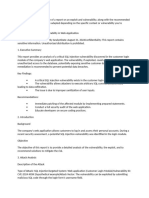0 ratings0% found this document useful (0 votes)
6 viewsCyberattacks-Assignment (Copy 1)
Uploaded by
sweetwithclipsCopyright
© © All Rights Reserved
We take content rights seriously. If you suspect this is your content, claim it here.
Available Formats
Download as DOCX, PDF, TXT or read online on Scribd
0 ratings0% found this document useful (0 votes)
6 viewsCyberattacks-Assignment (Copy 1)
Uploaded by
sweetwithclipsCopyright
© © All Rights Reserved
We take content rights seriously. If you suspect this is your content, claim it here.
Available Formats
Download as DOCX, PDF, TXT or read online on Scribd
You are on page 1/ 2
CYBER ATTACKS
1. Login Bypass Using SQL Injection
A user has reported that they were able to log into your web application without valid credentials. After
investigating, you find that they entered the following in the password field: 1234' OR '1'='1.
Describe how this SQL injection works, why it is a vulnerability, and the steps you would take to
prevent such issues.
2. Data Exfiltration via SQL Injection in Search Forms
Your e-commerce platform has a search feature that queries the database based on user input. A security
audit reveals that a simple search term like "product_id=-1' UNION SELECT username,
password FROM users --" returns user credentials instead of product data. Explain how this
form of SQL injection could lead to data exfiltration and what methods you would use to protect
sensitive data in such fields.
3. Detection of Blind SQL Injection through Time Delays
During a penetration test, it is found that appending "AND SLEEP(5)" to an input field causes the
web application to delay responses by five seconds. What is a blind SQL injection, and how does this
technique help attackers probe the database? Detail how you could detect and remediate blind SQL
injection vulnerabilities in the system.
4. Cross-Database SQL Injection Attacks
Your multi-platform database application integrates with MySQL, PostgreSQL, and MS SQL
databases. During testing, a vulnerability is identified where the input "'; EXEC
xp_cmdshell('whoami') --" executes on the MS SQL database and reveals sensitive OS-level
information. Discuss how SQL injection can vary across databases, the risks of system-level command
execution, and the mitigation strategies for cross-database security.
5. SQL Injection in JSON-Based API Requests
Your web service offers a RESTful API where clients send JSON payloads. However, an attacker finds
that adding SQL code into certain JSON fields retrieves unauthorized data. Explain how SQL injection
can occur in JSON-based APIs, the risks involved, and how you would secure such APIs against
injection attacks.
6. Stored SQL Injection through User Profile Data
A vulnerability has been reported in your social media application: a user can insert SQL commands in
their profile's "About Me" section, which is later executed by an admin user viewing it. How does
stored SQL injection differ from other types, and why is it particularly dangerous? Outline measures
you would implement to prevent stored SQL injection vulnerabilities in user-generated content.
7. Second-Order SQL Injection
Your company has a sign-up form that validates inputs for SQL injection. However, SQL injection
occurs in an internal application that processes user registration data after they sign up. Describe a
second-order SQL injection, how it can go undetected during input validation, and what safeguards you
would establish to protect against it.
8. Privilege Escalation through SQL Injection
A SQL injection vulnerability in a report generation tool allows an attacker to gain admin access to the
database by elevating their privileges. How can SQL injection lead to privilege escalation, and what
potential database and system-level risks could result? Explain the steps needed to prevent
unauthorized privilege escalation.
9. Detecting SQL Injection with WAF (Web Application Firewall)
A user has triggered several alarms on your Web Application Firewall (WAF) by inputting SQL-
specific commands like UNION SELECT and ORDER BY 1. Discuss how a WAF detects SQL
injection attempts, the limitations of WAFs in detecting advanced SQL injection attacks, and the
measures you’d take to complement WAF security.
10. SQL Injection in Stored Procedures
Your team finds a vulnerability in a stored procedure that concatenates user input into a query before
executing it. Explain why stored procedures are generally safer but still vulnerable to SQL injection if
not parameterized. Describe how to write secure stored procedures and prevent SQL injection even
when using database-side code.
You might also like
- Detection of SQL Injection Using Machine Learning: A SurveyNo ratings yetDetection of SQL Injection Using Machine Learning: A Survey8 pages
- A System For The Prevention of SQL Injection Attacks: Spring 2023No ratings yetA System For The Prevention of SQL Injection Attacks: Spring 20236 pages
- Breaking Down The 5 Most Common SQL Injection ThreatsNo ratings yetBreaking Down The 5 Most Common SQL Injection Threats27 pages
- A Method of Detecting SQL Injection Attack To Secure Web ApplicationsNo ratings yetA Method of Detecting SQL Injection Attack To Secure Web Applications9 pages
- SQL Injection, Are Your Web Applications VulnerableNo ratings yetSQL Injection, Are Your Web Applications Vulnerable31 pages
- A Novel System For Detecting and Preventing SQL Injection and Cross-Site-ScriptNo ratings yetA Novel System For Detecting and Preventing SQL Injection and Cross-Site-Script6 pages
- Advanced SQL Injection Attacks-1722063795994No ratings yetAdvanced SQL Injection Attacks-172206379599438 pages
- Prevention of SQL Injection Attacks by Using Service Oriented Authentication TechniqueNo ratings yetPrevention of SQL Injection Attacks by Using Service Oriented Authentication Technique5 pages
- SQL Injection: Are Your Web Applications Vulnerable?No ratings yetSQL Injection: Are Your Web Applications Vulnerable?32 pages
- Application Vulnerabilities and DefencesNo ratings yetApplication Vulnerabilities and Defences12 pages
- Sub: Web Security Name: Shubham Sati ROLL NO: 17BCA1100 Class: Bca5CNo ratings yetSub: Web Security Name: Shubham Sati ROLL NO: 17BCA1100 Class: Bca5C7 pages
- A Comprehensive Guide to SQL Injection Prevention 1 6No ratings yetA Comprehensive Guide to SQL Injection Prevention 1 67 pages
- Ethical Hacking v10: Module 13 - SQL Injection0% (1)Ethical Hacking v10: Module 13 - SQL Injection43 pages
- SQL Injection Attacks Techniques and Protection MechanismNo ratings yetSQL Injection Attacks Techniques and Protection Mechanism17 pages
- A Review On SQL Injection Prevention Technique: Navu - Verma@yahoo - inNo ratings yetA Review On SQL Injection Prevention Technique: Navu - Verma@yahoo - in6 pages
- SQLinjectionattacksonwebapplications IJACSA 2014No ratings yetSQLinjectionattacksonwebapplications IJACSA 20146 pages
- Sat - 94.Pdf - Detection of SQL Injection Attack Usiing Adaptive Deep ForestNo ratings yetSat - 94.Pdf - Detection of SQL Injection Attack Usiing Adaptive Deep Forest11 pages
- SQL-Injections: A Wake-Up Call For DevelopersNo ratings yetSQL-Injections: A Wake-Up Call For Developers41 pages
- A MACHINE LEARNING APPROACH TO PREVENTING SQL INJECTION ATTACK ON CRITICAL INFORMATION INFRASTRUCTURENo ratings yetA MACHINE LEARNING APPROACH TO PREVENTING SQL INJECTION ATTACK ON CRITICAL INFORMATION INFRASTRUCTURE47 pages
- 10.Web Application Security-SQL InjectionNo ratings yet10.Web Application Security-SQL Injection42 pages
- Web Application Vulnerabilities: Bhanu Pratap YadavNo ratings yetWeb Application Vulnerabilities: Bhanu Pratap Yadav61 pages
- Detection of SQL Injection Attack in Web Applications Using Web ServicesNo ratings yetDetection of SQL Injection Attack in Web Applications Using Web Services8 pages
- Writing: A Website Review - Exercises: PreparationNo ratings yetWriting: A Website Review - Exercises: Preparation2 pages
- MA108 ODE: Solving First Order ODE's Lecture 2 (D3 & D4) : Prachi Mahajan IIT BombayNo ratings yetMA108 ODE: Solving First Order ODE's Lecture 2 (D3 & D4) : Prachi Mahajan IIT Bombay24 pages
- Folklore - Malin Kundang - English Version - ( EF - English First Version )No ratings yetFolklore - Malin Kundang - English Version - ( EF - English First Version )17 pages
- Trade marketing -Hướng dẫn tiểu luận cuối kỳ chính thức (17.05.2023)No ratings yetTrade marketing -Hướng dẫn tiểu luận cuối kỳ chính thức (17.05.2023)15 pages
- Ledger-Ndaries: List of DEPED Programs and or Orders To Alleviate or Eradicate Illiteracy in Our CountryNo ratings yetLedger-Ndaries: List of DEPED Programs and or Orders To Alleviate or Eradicate Illiteracy in Our Country6 pages
- Start Deutsch A1 Exam Sprechen Teil 2 PPT 7No ratings yetStart Deutsch A1 Exam Sprechen Teil 2 PPT 71 page
- Ielts Writing and Speaking Skills Get A 7 (Ielts Thu Dang)No ratings yetIelts Writing and Speaking Skills Get A 7 (Ielts Thu Dang)122 pages
- Pronouns and Types: Prepared By: Chong Li Min Yok Wei LiangNo ratings yetPronouns and Types: Prepared By: Chong Li Min Yok Wei Liang14 pages
- OceanofPDF.com Serious Concerns - Wendy CopeNo ratings yetOceanofPDF.com Serious Concerns - Wendy Cope92 pages

























































































